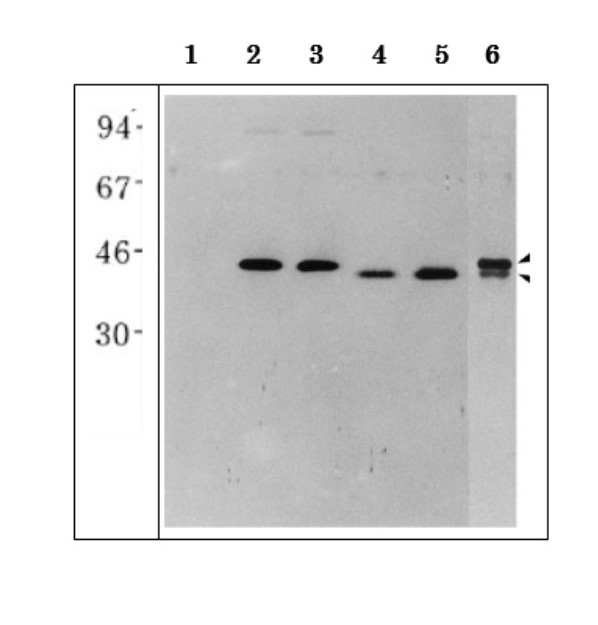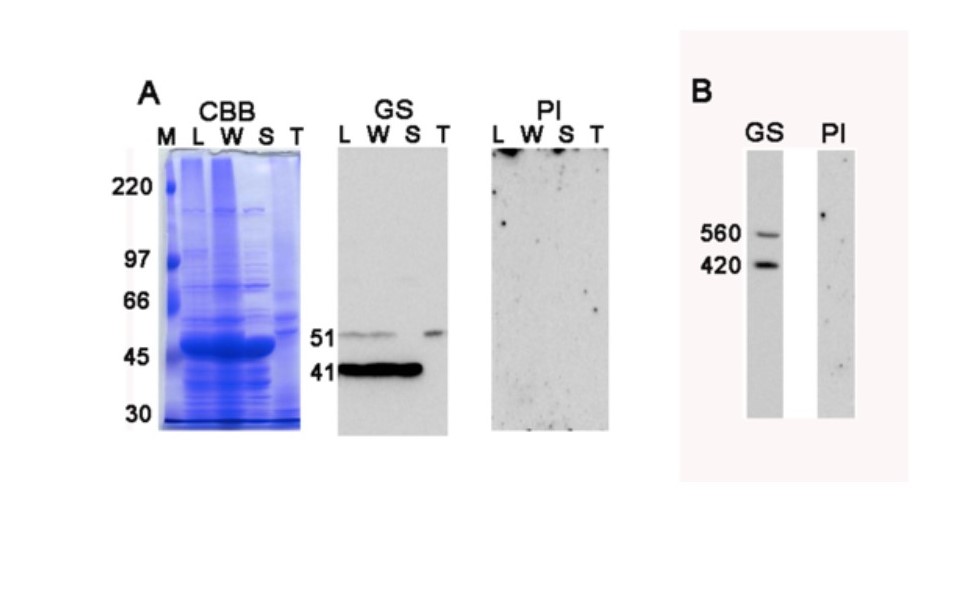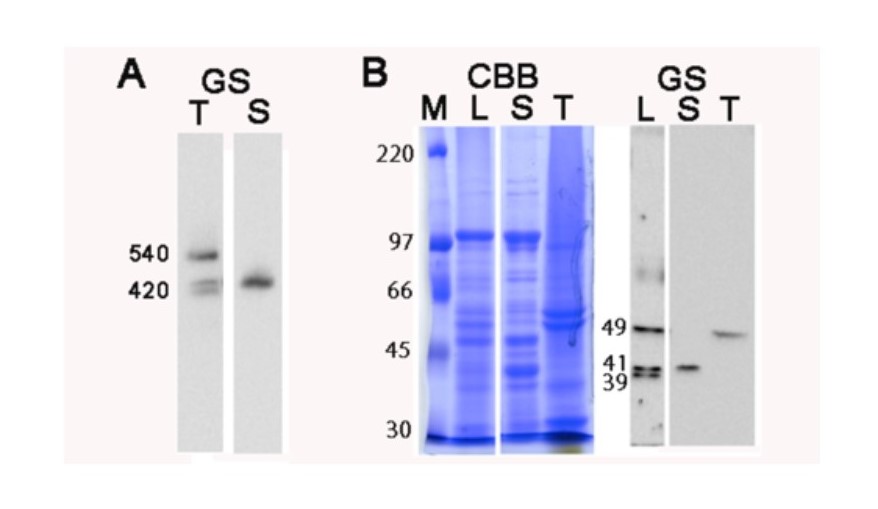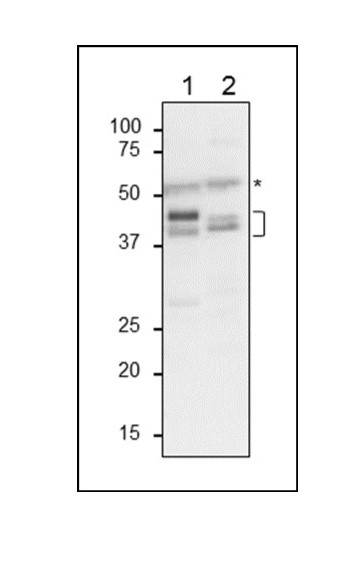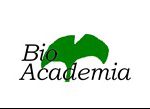Description
Background:
Plays a role in the flow of nitrogen into nitrogenous organic compounds. Five root types of GS isoproteins (GS1-1~ GS1-5) and one chloroplastic GS isoprotein (GS2/GLN2) are known. The sequence identity between GS1-1 and GS2 is 65% identical.
Specifications:
Storage: Shipped at 4°C and store at -20℃
Form: 2 mg/ml in PBS, 50% glycerol. Filter sterilized. No preservative or carrier added.
Purity: IgG, affinity-purified with Protein A/G mix
Immunogen: Purified recombinant maize GS1-1 (Glutamine synthetase, root isozyme 1)
protein (full-size, no-tag attached)
Reactivity: Plant Glutamine Synthetase isoproteins including those of Maize, Spinach and Arabidopsis
Applications
- Western blot (1/1,000- 1/5,000 dilution)
- ELISA (assay dependent)
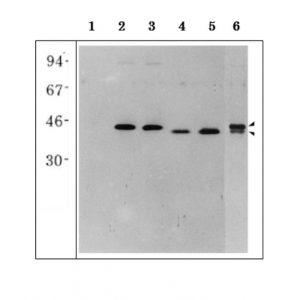
Fig. 1 Western blot of E. coli extracts overexpressing recombinant maize root type GS isoproteins.
- Negative control without recombinant GS
- GS1-1 expressing extract
- GS1-2 expressing extract
- GS1-3 expressing extract
- GS1-4 expressing extract
- Maize root extract treated with ammonia
The lower band is ammonia induced GS.
Molecular mass is indicated in left (kDa)
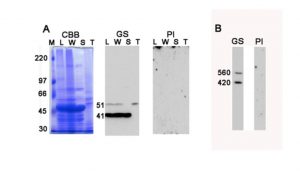
Fig. 2. Western analysis of spinach proteins by SDS-PAGE (A) and BN-PAGE (B). A: Total proteins from spinach leaves (lane L), whole chloroplasts (W), stroma (S) and thylakoid fraction (T) were analyzed by western blot after 7.5% SDS-PAGE probed with anti-GS antibody (GS) and preimmune serum (PI). In spinach leaves, only GS2 isoprotein is considered to be expressed [ref. S1] and is thought to be detected by the polyclonal antibody against maize GS1a proteins that shares 75% identity with spinach GS2, through the consequence of the cross-reactivity of the antibody by recognizing the epitopes common to the two GS isozymes. As expected from the western analysis of the whole chloroplasts by 2D BN/SDS-PAGE, stroma and thylakoid fractions contained the polypeptides with distinct sizes of approx. 41 kDa and 51 kDa, respectively. The deduced MWs are somewhat different from those in the 2D analysis (45 kDa and 55kDa), but the size in the stromal fraction of the 1D SDS-PAGE (41 kDa) appears to be closer to the estimated size of spinach GS2 protein (372 residues) and would be more accurate than the 2D analysis. B: Proteins extracted from whole chloroplasts were analyzed by western blot after BN-PAGE, probed with anti-GS antibody (GS) and preimmune serum (PI). The numbers beside each band stand for the estimated molecular weights. All the samples loaded were derived from 10 μg on a chlorophyll basis of chloroplasts whose proteins were extracted.
Adopted from Kimata-Ariga Y and Hase T. PLoS One. 2014 Oct 1;9(10):e108965.
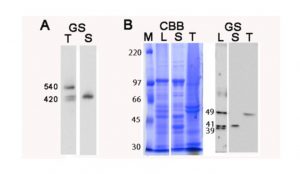
Fig. 3 Western analysis of maize proteins by BN-PAGE (A) and SDS-PAGE (B). A: Thylakoid (T) and stroma (S) proteins were extracted from maize chloroplasts, and were analyzed by western blot after BN-PAGE, probed with anti-GS antibody (GS). The pattern is quite similar to that of spinach leaves, although the mobility of the major band detected in the lane of thylakoid proteins is slightly faster (approx. 540 kDa) than that of spinach (560 kDa). B: Total proteins from maize leaves (lane L), stroma (S) and thylakoid fraction (T) were analyzed by western blot after 7.5% SDS-PAGE, probed with anti-GS antibody (GS). The analysis showed the bands, 41 kDa for stroma and 49 kDa for thylakoids, which are similar to those of spinach. The relative content of the maize GS2 protein in the stromal fraction appears to be lower compared to that of spinach. Additional lowest band detected in the lane of the whole leaves is thought to be a cytosolic GS1 protein (39 kDa), which is known to be absent in spinach leaves, leading to the confirmation that the anti-GS antibody reacts with both GS1 and GS2. Thus, the patterns of the GS signals detected in the stroma and thylakoid fractions of maize chloroplasts were basically the same as those of spinach on both BN-PAGE and SDS-PAGE analyses. The numbers beside each band stand for the estimated molecular weights.
Adopted from Kimata-Ariga Y and Hase T. PLoS One. 2014 Oct 1;9(10):e108965.
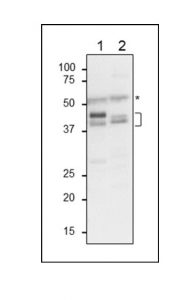
Fig. 4 Western Blot of Glutamine Synthetase isoproteins in plant leaf extracts.
Anti-GS1 antiserums was used at 1/1,000 dilution. Second antibody (goat anti-rabbit IgG antibody HRP-conjugated, ab97051) was used at 1/10,000 dilution.
- Arabidopsis leaf extract, 2 μg
- Maize leaf extract, 2 μg
Molecular masses of GS1 isoproteins are 38-40 kDa
This antibody reacts both leaf and root types of the isoporteins. Maize leaf contains both types.
Asterisk indicates the band for chloroplastic GS (46 kDa) that
migrates at position of 51 kDa in SDS-PAGE (Ref.3).

